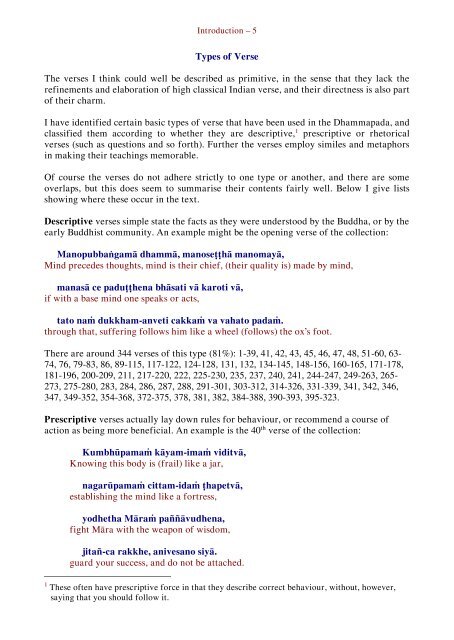Dhammapada, Dhamma Verses (KN 2)
Pāli verses with English translation in this collection of 423 Dhamma verses, along with a discussion of their meaning and their collection.
Pāli verses with English translation in this collection of 423 Dhamma verses, along with a discussion of their meaning and their collection.
- TAGS
- dhamma
- dhammapada
You also want an ePaper? Increase the reach of your titles
YUMPU automatically turns print PDFs into web optimized ePapers that Google loves.
Introduction – 5<br />
Types of Verse<br />
The verses I think could well be described as primitive, in the sense that they lack the<br />
refinements and elaboration of high classical Indian verse, and their directness is also part<br />
of their charm.<br />
I have identified certain basic types of verse that have been used in the <strong><strong>Dhamma</strong>pada</strong>, and<br />
classified them according to whether they are descriptive, 1 prescriptive or rhetorical<br />
verses (such as questions and so forth). Further the verses employ similes and metaphors<br />
in making their teachings memorable.<br />
Of course the verses do not adhere strictly to one type or another, and there are some<br />
overlaps, but this does seem to summarise their contents fairly well. Below I give lists<br />
showing where these occur in the text.<br />
Descriptive verses simple state the facts as they were understood by the Buddha, or by the<br />
early Buddhist community. An example might be the opening verse of the collection:<br />
Manopubbaṅgamā dhammā, manoseṭṭhā manomayā,<br />
Mind precedes thoughts, mind is their chief, (their quality is) made by mind,<br />
manasā ce paduṭṭhena bhāsati vā karoti vā,<br />
if with a base mind one speaks or acts,<br />
tato naṁ dukkham-anveti cakkaṁ va vahato padaṁ.<br />
through that, suffering follows him like a wheel (follows) the ox’s foot.<br />
There are around 344 verses of this type (81%): 1-39, 41, 42, 43, 45, 46, 47, 48, 51-60, 63-<br />
74, 76, 79-83, 86, 89-115, 117-122, 124-128, 131, 132, 134-145, 148-156, 160-165, 171-178,<br />
181-196, 200-209, 211, 217-220, 222, 225-230, 235, 237, 240, 241, 244-247, 249-263, 265-<br />
273, 275-280, 283, 284, 286, 287, 288, 291-301, 303-312, 314-326, 331-339, 341, 342, 346,<br />
347, 349-352, 354-368, 372-375, 378, 381, 382, 384-388, 390-393, 395-323.<br />
Prescriptive verses actually lay down rules for behaviour, or recommend a course of<br />
action as being more beneficial. An example is the 40 th verse of the collection:<br />
Kumbhūpamaṁ kāyam-imaṁ viditvā,<br />
Knowing this body is (frail) like a jar,<br />
nagarūpamaṁ cittam-idaṁ ṭhapetvā,<br />
establishing the mind like a fortress,<br />
yodhetha Māraṁ paññāvudhena,<br />
fight Māra with the weapon of wisdom,<br />
jitañ-ca rakkhe, anivesano siyā.<br />
guard your success, and do not be attached.<br />
1<br />
These often have prescriptive force in that they describe correct behaviour, without, however,<br />
saying that you should follow it.


















